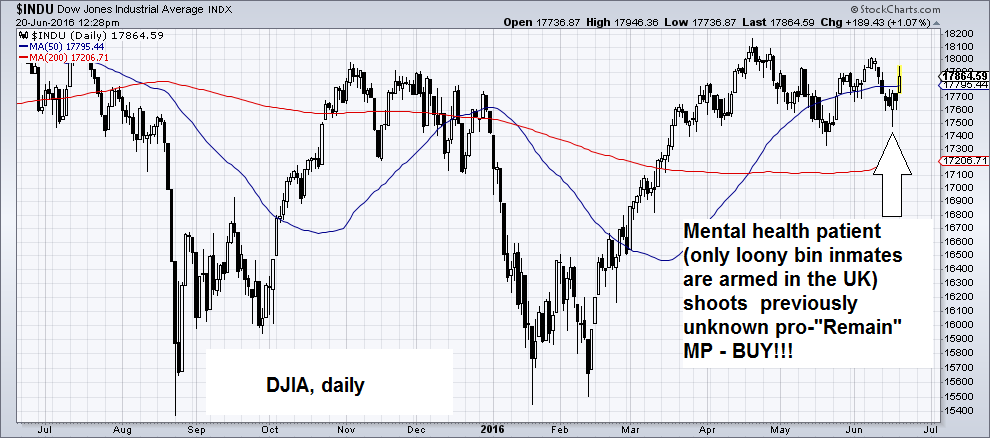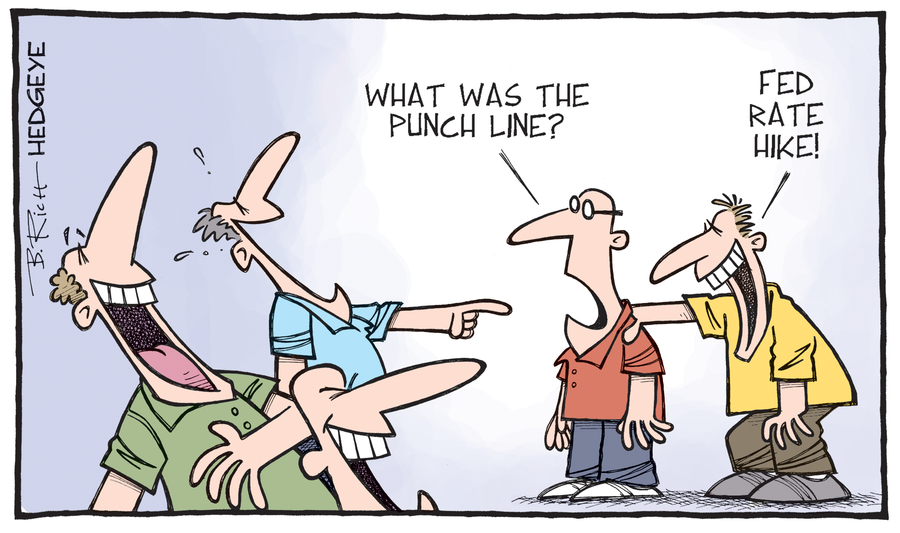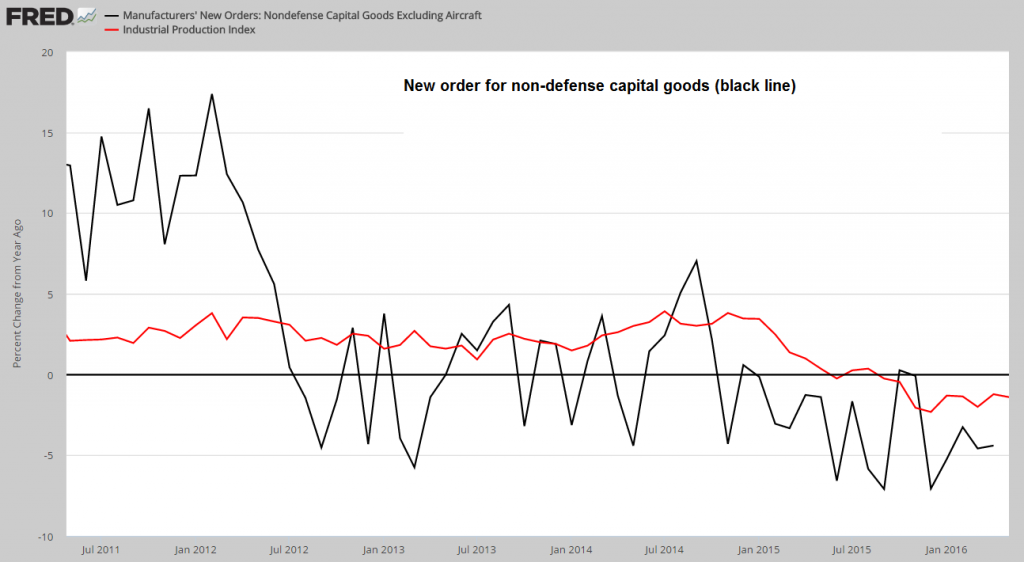Summary More than trillion of government bonds now trade at negative yields. And another trillion or so worth of U.S. stocks trade well above their long-term average valuations. And there’s more than 0 trillion of debt in the world. All of this sits on the Fed’s financial applecart. Does Janet Yellen dare upset it? Blame “Brexit” BALTIMORE – The U.S. stock market broke its losing streak on Thursday [and even more so on Monday, ed.]. After five straight losing sessions, the Dow eked out a 92-point gain. The financial media didn’t know what to say about it. So, we ended up with the typical inanities, myths, and claptrap. “Investors” are pushing the DJIA back up again..apparently any excuse will do at the moment. The idea may backfire though, as exactly the same thing happened shortly before Sweden’s euro referendum (a prominent pro-euro politician was killed by a “lone nut” a few days ahead of the vote), and Sweden still had the krona last we looked… Dow Jones Industrial Average INDX – click to enlarge. “Brexit panic may be your big chance to buy the S&P 500,” says a headline at Marketwatch. The article claims investors have pushed down the value of the S&P 500 in fear of a so-called “Brexit.
Topics:
Bill Bonner considers the following as important: Central Banks, Debt and the Fallacies of Paper Money, Dow Jones Industrial Average, Featured, Janet Yellen, newsletter, US manufacturing sector
This could be interesting, too:
Nachrichten Ticker - www.finanzen.ch writes Die Performance der Kryptowährungen in KW 9: Das hat sich bei Bitcoin, Ether & Co. getan
Nachrichten Ticker - www.finanzen.ch writes Wer verbirgt sich hinter der Ethereum-Technologie?
Martin Hartmann writes Eine Analyse nach den Lehren von Milton Friedman
Marc Chandler writes March 2025 Monthly
Summary
More than $10 trillion of government bonds now trade at negative yields. And another $10 trillion or so worth of U.S. stocks trade well above their long-term average valuations.
And there’s more than $200 trillion of debt in the world. All of this sits on the Fed’s financial applecart. Does Janet Yellen dare upset it?
Blame “Brexit”BALTIMORE – The U.S. stock market broke its losing streak on Thursday [and even more so on Monday, ed.]. After five straight losing sessions, the Dow eked out a 92-point gain. The financial media didn’t know what to say about it. So, we ended up with the typical inanities, myths, and claptrap. “Investors” are pushing the DJIA back up again..apparently any excuse will do at the moment. The idea may backfire though, as exactly the same thing happened shortly before Sweden’s euro referendum (a prominent pro-euro politician was killed by a “lone nut” a few days ahead of the vote), and Sweden still had the krona last we looked… |
|
| “Brexit panic may be your big chance to buy the S&P 500,” says a headline at Marketwatch. The article claims investors have pushed down the value of the S&P 500 in fear of a so-called “Brexit.”
Next Thursday, in a national referendum, British voters will decide whether to end Britain’s 43-year membership in the European Union. But there are a number of problems with this… First, there has been no big rout in the S&P 500; it’s only slightly below its all-time high. Second, Brexit is a mystery to most U.S. investors, not a cause for alarm. Third, nobody knows which side will win – or what it will mean. Would a Brexit be good for Britain? Would it be bad for stocks? Nobody knows! Meanwhile, the Financial Times focuses on “slowing job growth and risk of Brexit…” It notes that a possible Brexit next week is one reason Fed chief Janet Yellen cited for holding off on raising U.S. interest rates at this week’s monetary policy meeting. The newspaper also notes that the Fed has left “the door open” to rate increases. We’ve been saying the same thing for years: The Fed will NEVER follow through on its pledge to return interest rates back to “normal.” Never is a long time; but so far, so good. The door is still nailed shut. |
|
On EdgeFirst, the Fed waited until last December to pry open a single quarter-point rate increase. That took the federal funds rate – the base lending rate of the entire economy – to all of 0.25 – 0.5%. When that set the world’s nerves on edge, the Fed did as we warned it would: It put away the crowbar… procrastinated… hesitated… mumbled… and dragged its feet. Every month brought a new meeting of the Fed’s monetary policy committee… and each meeting brought forth an effluent rich in waffle and hocus-pocus. The Fed’s chief witch doctor, Janet Yellen, says the committee will make its decision based on the incoming data. The next move toward normalization of interest rates will be “data dependent,” she insists. That idea is preposterous, too. These are markets we’re talking about; they go up and down. After so many years of a bull market on Wall Street, Mr. Market must be planning for a change. Stocks gotta go down sometime. Can the Fed raise rates in the face of falling stock prices? We don’t think so. And with the annual rate U.S. GDP growth falling below 1% in the first three months of the year, a prudent investor should prepare for a little backsliding in the economy, too. Will the Fed cling to its “normalizing” program when a recession sets in? Nah. Bear markets and recessions are facts of life. Because mistakes are facts of life. That’s why markets go up and down. People pay too much for stocks; they need to take a breather until their companies are worth what they paid for them. Businesses invest too much… hire too many people… produce more than they can sell. Occasionally, they, too, need to slow down, work down their inventories, lay off workers and prepare for the next growth spurt. |
|
Upsetting the ApplecartThere is no magic to this, nothing new to these patterns. Yet investors are surprised every time! The headline news is still relatively good – positive GDP growth, high stock prices, and presidential candidates who will “Make America Great Again.” What more could we want? And yet, even with these benign conditions, the Yellen Fed is fearful. It won’t take a chance. It won’t make a move. The door is not open; it’s closed. Of course, the Fed knows that the headlines mask the real weaknesses in the economy. Industrial production has been falling for nine months in a row. Factory orders have been going down for the past 18 months. Commercial bankruptcies are rising. And tax receipts are beginning to fall, as they typically do before a recession. More than $10 trillion of government bonds now trade at negative yields. And another $10 trillion or so worth of U.S. stocks trade well above their long-term average valuations. And there’s more than $200 trillion of debt in the world – with about $60 trillion added since the global financial crisis. All of this sits on the Fed’s financial applecart. Does Janet Yellen dare upset it? Nah. It will have to upset itself. |
Charts by: StockCharts, St. Louis Federal Reserve Research
Chart and image captions by PT
The above article originally appeared at the Diary of a Rogue Economist, written for Bonner & Partners.




